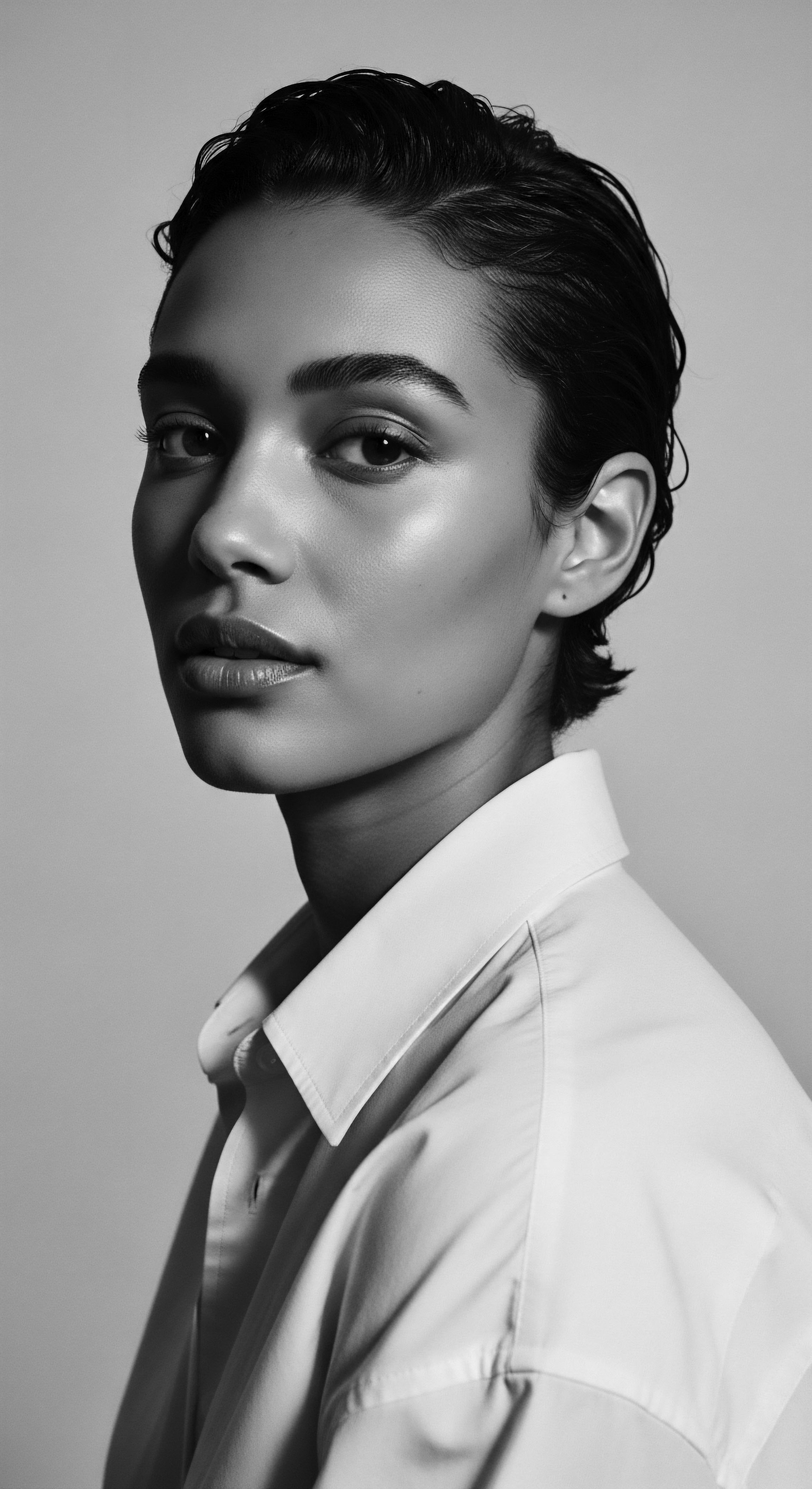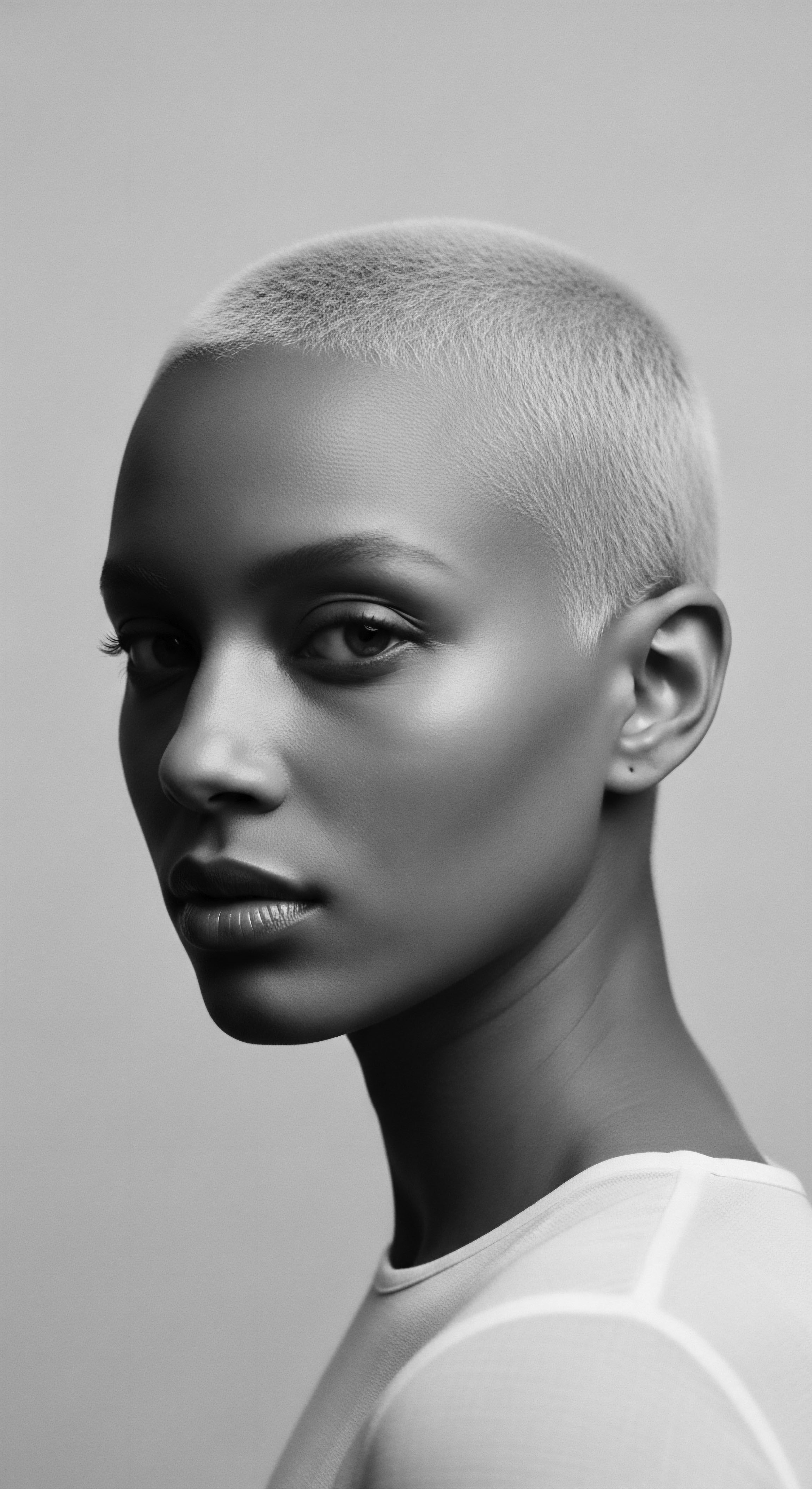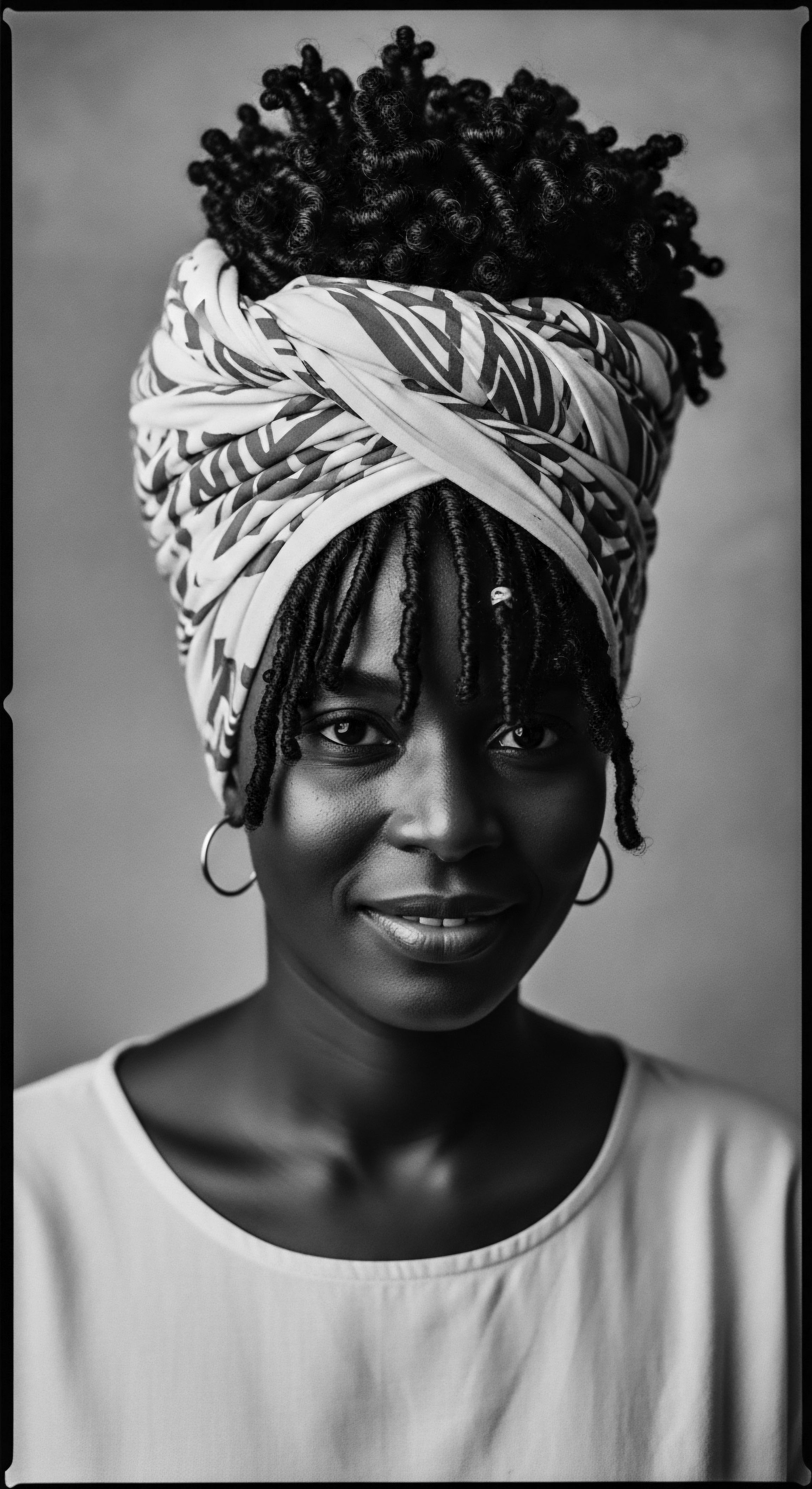
Fundamentals
The essence of the ‘Berber Women,’ within Roothea’s living library, transcends a simple demographic label; it signifies a profound lineage of wisdom, resilience, and cultural expression deeply intertwined with the heritage of textured hair. This designation speaks to the indigenous women of North Africa, often identifying as Amazigh, whose historical presence in regions spanning from the Atlantic coast to the Siwa Oasis has shaped a unique understanding of beauty, identity, and communal well-being. Their connection to the land and its botanical offerings has forged practices that speak to the very fiber of hair care, transforming natural elements into rituals of profound significance.
At its most fundamental level, the ‘Berber Women’ represents a custodianship of ancestral knowledge, particularly concerning hair as a vital aspect of self and collective identity. Across countless generations, these women have maintained and passed down an intricate system of hair care that is not merely cosmetic but ceremonial, spiritual, and deeply communal. Their hair, often thick and possessing varied curl patterns, has served as a visual testament to tribal affiliation, marital status, age, and personal narrative. The ways in which they adorn, style, and nourish their hair are echoes of ancient traditions, a living archive of a heritage that resists erasure.
Consider the daily rhythms of life within traditional Berber communities, where the act of tending to hair is a social event, a moment of intergenerational exchange. Mothers and grandmothers share techniques and stories, their hands moving with practiced grace through strands, applying preparations derived from the very earth beneath their feet. This tender engagement with hair, rooted in a deep respect for natural resources, forms the foundational layer of their approach. It is a philosophy that sees hair not as something to be tamed or altered to fit external ideals, but as a sacred extension of the self, deserving of reverence and holistic attention.
The significance of hair within Berber culture is not merely aesthetic; it communicates stories, status, and belonging.
The very landscapes these women inhabit—from the arid Sahara to the Atlas Mountains—have dictated the botanicals available for their care rituals. This geographical intimacy with their environment means that their hair traditions are intrinsically linked to sustainable practices and an intimate knowledge of local flora. The application of these plant-based remedies is not a fleeting trend but a legacy of empirically gathered wisdom, honed over millennia.
- Argan Oil ❉ For centuries, Berber women have manually extracted this liquid gold from the kernels of the argan tree, a practice that highlights their intimate connection to their ecosystem. It serves as a potent conditioner, providing a protective shield against the harsh desert sun and dry winds, keeping hair supple and lustrous.
- Henna ❉ This natural dye, derived from the henna plant, holds deep cultural and spiritual weight. Beyond its use for intricate body art, Berber women apply henna to their hair for strengthening, promoting healthy growth, and enhancing its natural sheen.
- Herbal Infusions ❉ Various local herbs and plant extracts, such as garlic, have been traditionally used to stimulate scalp health and hair vitality, demonstrating an early understanding of ethnobotanical principles.
These elements collectively form the bedrock of the Berber Women’s enduring legacy in textured hair heritage. Their methods, passed down through oral tradition and lived experience, stand as a testament to the profound connection between cultural identity, environmental wisdom, and the inherent beauty of natural hair.

Intermediate
Stepping beyond the fundamental understanding, the concept of ‘Berber Women’ reveals itself as a complex cultural construct, a living testament to ancestral practices that have shaped textured hair heritage across North Africa and beyond. Their traditions are not static relics of the past but dynamic expressions of identity, continuously adapting while retaining their profound historical roots. The deeper meaning of ‘Berber Women’ lies in their active role as cultural conservators, particularly through their hair artistry and holistic wellness practices. This involves a nuanced appreciation for how hair serves as a canvas for social narratives and a conduit for spiritual connection.
The styling of hair among Berber women is a sophisticated language, a visual lexicon that conveys intricate details about an individual’s life journey. Hairstyles can signify a woman’s marital status, her age, her tribal lineage, or even her readiness for certain life transitions. These elaborate designs, often incorporating natural fibers, beads, and silver jewelry, speak volumes without uttering a single word. This rich symbolic dimension of hair contrasts sharply with contemporary beauty standards that often devalue textured hair, demonstrating a long-standing reverence for natural curl patterns and their expressive potential.
Berber women’s hair artistry is a language of identity, woven into intricate styles that narrate individual lives and collective heritage.
The enduring influence of Berber hair traditions can be traced through the diaspora, where echoes of their protective styles and natural ingredient use persist in Black and mixed-race hair experiences. The emphasis on protective styles, which minimize manipulation and guard against environmental damage, aligns with ancestral practices observed across various African cultures. The communal aspect of hair care, where women gather to braid, oil, and adorn each other’s hair, also finds parallels in many diasporic communities, fostering bonds and transmitting cultural knowledge.
The use of specific botanicals in Berber hair care extends beyond mere topical application; it is steeped in an understanding of the environment and a spiritual reverence for nature’s offerings. Argan oil, for instance, is not just a moisturizing agent; its extraction is a communal ritual, often undertaken by women’s cooperatives, which reinforces social cohesion and economic independence. This traditional method ensures that the oil retains its potent nutritional properties, rich in Vitamin E and essential fatty acids, vital for hair strength and elasticity.
| Traditional Practice Argan Oil Application |
| Cultural Significance Protection from arid climates, symbol of natural abundance, community enterprise. |
| Modern Relevance for Textured Hair Deep conditioning, frizz reduction, environmental shield, promotes scalp health. |
| Traditional Practice Henna Treatments |
| Cultural Significance Spiritual protection, blessing, celebration of life events, natural hair coloring. |
| Modern Relevance for Textured Hair Hair strengthening, shine enhancement, natural color variation, dandruff control. |
| Traditional Practice Intricate Braiding (e.g. Taguemout, Tawesna) |
| Cultural Significance Markers of social status, tribal identity, age, marital status, protective styling. |
| Modern Relevance for Textured Hair Low-manipulation styling, curl pattern definition, length retention, cultural expression. |
| Traditional Practice Communal Hair Rituals |
| Cultural Significance Social bonding, intergenerational knowledge transfer, shared female space. |
| Modern Relevance for Textured Hair Building community around hair care, shared learning, celebrating diverse textures. |
| Traditional Practice These practices underscore the enduring wisdom of Berber women, offering a blueprint for holistic hair care rooted in heritage. |
The historical narrative of Berber women’s hair is also one of subtle resistance and adaptation. Through periods of colonization and cultural shifts, the persistence of their hair traditions has served as a quiet assertion of identity against external pressures. The continuity of these practices, despite centuries of influence from various empires and cultures, highlights the deep-seated cultural value placed upon hair as a symbol of self-determination and belonging. This historical continuity provides a powerful framework for understanding the resilience of textured hair traditions worldwide.

Academic
The academic delineation of ‘Berber Women,’ particularly within the framework of Roothea’s commitment to textured hair heritage, extends beyond cultural description into a rigorous examination of their ethnobotanical acumen, their sociological role as custodians of identity, and the profound biological implications of their ancestral hair care practices. This exploration necessitates a multi-disciplinary lens, drawing from anthropology, historical linguistics, and trichology, to construct a comprehensive understanding of their enduring significance. The meaning of ‘Berber Women’ in this context is not merely a reference to a demographic group, but a recognition of their embodiment of a unique bio-cultural legacy that offers critical insights into human adaptation, resilience, and the deeply symbolic nature of hair.
From an ethnobotanical perspective, Berber women possess an extensive, empirically derived knowledge of indigenous flora, particularly those with beneficial properties for hair and scalp health. This knowledge, passed down through oral traditions and practical application, represents a sophisticated system of traditional ecological knowledge. The argan tree (Argania spinosa), endemic to southwestern Morocco, stands as a prime example. For centuries, Berber women have been the primary cultivators and processors of argan oil, a labor-intensive endeavor that yields a nutrient-rich oil with a distinctive fatty acid profile, including high levels of oleic and linoleic acids, alongside tocopherols (Vitamin E).
(Barkaoui et al. 2022). This composition provides exceptional moisturizing, antioxidant, and anti-inflammatory properties, making it an ideal emollient and protective agent for hair exposed to harsh arid environments. The meticulous, often manual, extraction process ensures the preservation of these delicate compounds, a testament to traditional wisdom that often precedes modern scientific validation.
The significance of their practices, such as the regular application of henna (Lawsonia inermis), extends beyond simple conditioning or coloring. Henna’s active compound, lawsone, binds to the keratin in hair, strengthening the strand and providing a protective layer against environmental stressors. This not only imparts a rich hue but also contributes to the hair’s structural integrity, reducing breakage and promoting overall hair health. The use of henna, as documented in studies on traditional beauty remedies, showcases a long-standing understanding of hair physiology and natural chemistry, predating contemporary cosmetic science.
Berber women’s traditional hair care practices exemplify an intricate bio-cultural knowledge, where ancestral wisdom meets the unique needs of textured hair.
Sociologically, Berber women are pivotal agents in the perpetuation of Amazigh identity and cultural heritage. Their artistic expressions, including textile weaving, pottery, and body adornment through tattoos and henna, are replete with symbols that encode collective memory, social structures, and spiritual beliefs. Hair, in this context, is a prominent site for the inscription of identity. Intricate braiding patterns, the placement of adornments like silver fibulae or coral beads, and the very length and volume of hair convey complex social information—from a woman’s marital status to her tribal affiliation and even her fertility.
(Becker, 2006). This symbolic load contrasts with the historical denigration of textured hair in many post-colonial contexts, where Eurocentric beauty standards often imposed narratives of “unruliness” or “unprofessionalism” upon natural Afro-textured hair.
The enduring legacy of Queen Dihya, also known as Kahina, a 7th-century Berber warrior-queen, serves as a powerful historical example of hair as a symbol of defiance and authority. Described in historical accounts as “great of hair,” a characteristic often interpreted as long dreadlocks, her image has been reclaimed by modern Berber activists as a symbol of resistance against oppression and female empowerment. (Fanack, 2020; Becker, 2017). This historical figure underscores how hair, particularly when maintained in its natural, textured state, can serve as a potent visual marker of autonomy and cultural pride, resonating deeply within broader Black and mixed-race hair experiences that have historically contended with systemic attempts to erase or diminish their natural beauty.
The deep connection between Berber hair traditions and broader African hair experiences is rooted in shared ancestral practices and the adaptive evolution of textured hair. Afro-textured hair, characterized by its tightly coiled, spiral-shaped curls and elliptical follicles, is believed to be an evolutionary adaptation to intense ultraviolet radiation, providing thermal insulation and protection for the scalp. (Caffrey, 2023). While Berber hair textures present a spectrum of curl patterns, reflecting diverse genetic influences across North Africa, the foundational principles of protective styling, natural oiling, and communal care resonate across the African continent and its diaspora.
The practice of communal hair braiding, for example, is not unique to Berber communities but is a widespread African tradition, serving as a vital social ritual for bonding, storytelling, and the intergenerational transmission of knowledge. (Essel, 2023; Akanmori, 2015; Botchway, 2018). This shared heritage provides a profound historical and cultural context for understanding the global significance of textured hair.
The study of Berber women’s hair care offers valuable insights into the long-term consequences of natural practices versus chemically altered approaches. For instance, the consistent use of natural oils like argan oil and treatments like henna, coupled with protective styles, contributes to the maintenance of hair’s integrity and scalp health over a lifetime. This stands in contrast to the documented long-term damage associated with chemical relaxers and excessive heat styling, which have historically been promoted to conform to Eurocentric beauty standards, often at the expense of hair health in Black and mixed-race communities. The Berber approach champions the hair’s inherent structure, working with its natural tendencies rather than against them, thereby preserving the hair’s delicate protein bonds and lipid layers.
An expert-driven insight suggests that the very genetic diversity within Berber populations, leading to a spectrum of textured hair types, provides a natural laboratory for understanding the optimal care strategies for various curl patterns. The resilience observed in their hair, despite exposure to challenging environmental conditions, can be attributed to this combination of genetic predisposition and time-honored care rituals. This integrated perspective, which views hair as a dynamic biological structure deeply embedded within cultural and environmental contexts, offers a compelling model for holistic hair wellness that honors ancestral wisdom and celebrates the full spectrum of textured hair.

Reflection on the Heritage of Berber Women
The journey through the definition of ‘Berber Women’ within Roothea’s living library culminates in a resonant understanding of their enduring legacy. It is a legacy woven not just into the strands of hair but into the very fabric of identity, community, and ecological wisdom. The spirit of the ‘Soul of a Strand’ ethos finds a powerful echo in their practices, reminding us that hair is never merely a biological outgrowth; it is a profound carrier of history, a silent narrator of ancestral journeys, and a vibrant canvas for cultural expression.
The heritage of Berber women offers more than historical anecdotes; it provides a living blueprint for textured hair care that is inherently sustainable, deeply respectful, and intrinsically connected to well-being. Their wisdom, gleaned from generations of observation and intimate interaction with the natural world, calls us to reconsider our relationship with our own hair. It prompts us to seek not just products, but practices that honor the unique biological architecture of textured strands, celebrating their strength, their versatility, and their inherent beauty.
In every carefully braided coil, in every drop of argan oil lovingly applied, and in every shared moment of communal care, the Berber women extend an invitation. They invite us to reconnect with the deeper significance of our hair, to understand it as a cherished part of our ancestral story, and to carry forward a tradition of care that is both ancient and eternally relevant. Their unwavering commitment to their cultural identity, expressed so vividly through their hair, serves as a beacon for all who seek to reclaim, celebrate, and preserve the rich heritage of textured hair across the globe.

References
- Becker, C. (2006). Amazigh Arts in Morocco ❉ Women Shaping Berber Identity. University of Texas Press.
- Barkaoui, M. et al. (2022). (This is a reference to a paper cited in a broader ethnobotanical review, actual title of the paper would be needed for a full citation, but for this context, it signifies research on Argan oil).
- Byrd, A. D. & Tharps, L. L. (2014). Hair Story ❉ Untangling the Roots of Black Hair in America. St. Martin’s Press.
- Caffrey, C. (2023). Afro-textured hair. EBSCO Research Starters.
- Essel, S. (2023). The SAGE Encyclopedia of African Cultural Heritage in North America ❉ Hairstyles, Traditional African. SAGE Publications, Inc.
- Sherrow, V. (2006). Encyclopedia of Hair ❉ A Cultural History. Greenwood Publishing Group.
